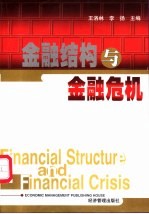图书介绍
金融结构与金融危机2025|PDF|Epub|mobi|kindle电子书版本百度云盘下载

- 王洛林,李扬主编 著
- 出版社: 北京:经济管理出版社
- ISBN:7801624335
- 出版时间:2002
- 标注页数:443页
- 文件大小:19MB
- 文件页数:469页
- 主题词:金融
PDF下载
下载说明
金融结构与金融危机PDF格式电子书版下载
下载的文件为RAR压缩包。需要使用解压软件进行解压得到PDF格式图书。建议使用BT下载工具Free Download Manager进行下载,简称FDM(免费,没有广告,支持多平台)。本站资源全部打包为BT种子。所以需要使用专业的BT下载软件进行下载。如BitComet qBittorrent uTorrent等BT下载工具。迅雷目前由于本站不是热门资源。不推荐使用!后期资源热门了。安装了迅雷也可以迅雷进行下载!
(文件页数 要大于 标注页数,上中下等多册电子书除外)
注意:本站所有压缩包均有解压码: 点击下载压缩包解压工具
图书目录
0 Introduction1
0·1 Financial Crisis:A Survey1
0 导论1
0.1 引言:金融危机概说1
0.2 关于金融危机的理论5
0·2 The Theories Concerning Financial Crisis5
0.3 实体经济变革迟缓:危机形成的基础10
0·3 The Delay of Economic Reform:The Sources of the Crisis10
0.3.1 实际经济增长速度和外债的偿还11
0.3.2 亚洲增长模式考察14
0.4 弊端重重的变革:东亚国家的金融自由化22
0·4 The Objections in the Process of Financial Crisis in Asian Countries22
0.4.1 金融约束:东亚国家金融体制的特征24
0.4.2 金融约束背景下的自由化的缺陷27
0.5 危机后的调整32
0·5 The Policy Adjustments after the Crisis32
0.6 对危机的理论反思37
0·6 Rethinking Asian Financial Crisis37
1·1 Introduction47
1 The Analysis of the Asian Development Model47
1.1 引言47
1 东亚经济增长模式分析47
1·2 The Contribution of the Product Factors48
1.2 要素的贡献48
1·3 The Efficiency of the Investments55
1.3 投资效率分析55
1.4 资源的动员59
1·4 Mobilization of the Economic Resources59
1.5 金融中介和金融部门的作用68
1·5 The Role of the Financial Intermediations and the Financial Sector68
1·6 The Export-based Development Strategy and the Liberalization of the Trade79
1.6 出口导向和贸易开放79
1.7 宏观经济稳定82
1·7 Stabilizing Macro-economy82
1·8 Rethinking Asian Development Model84
1.8.1 技术进步的关键作用84
1.8 反思东亚经济增长模式84
1.8.2 摒弃“政府主导型发展模式”88
2.1 引言92
2 The Relationship Between Financial System and the Financial Crisis92
2·1 Introduction92
2 金融体系和亚洲金融危机92
2.2 亚洲金融体系的特点93
2·2 The Feature of the Financial System in Asian Countries93
2.2.2 重视经常项目的平衡、严格管制资本项目96
2.2.1 利率受到严格管制,但名义利率和实际利率则处于较高的水平96
2.2.3 呆滞的证券市场97
2·3 The Comparative Advantages between Direct Finance and Indirect Finance99
2.3 市场融资和中介融资的比较优势99
2·4 Direct Finance and Indirect Finance:A Theoretical Analysis104
2.4 关于中介融资和市场融资的理论分析104
2.4.1 单一融资项目模型104
2.4.2 多个融资项目模型114
2.4.3 结论121
2·5 The Financial Bubble:A Point of Views of Financial123
2.5 亚洲金融体系和泡沫的形成123
2.5.1 泡沫的形成124
2.5.2 亚洲金融体系演变过程中的道德风险131
2.5.3 过度借贷的三个原因139
2.6 简短的结论141
2·6 System Summary141
3·1 Introduction143
3 The Institution of Enterprises and the Financial Crisis:A Case Study of Korea143
3 企业制度与金融危机:以韩国为例的分析143
3.1 引言143
3.2 韩国大企业发展战略的金融效应144
3·2 The Financial Effects of the Strategy of Great Enterprises144
3.2.1 企业的多元化经营战略与高负债政策效应145
3.2.2 优惠政策刺激了大企业的多元化扩张152
3.2.3 金融风险的形成机理160
3·3 The Financial Problems of Sansum Group:A Case Study163
3.3 案例分析:三星集团财务状况的金融透视163
3.3.1 三星集团的1996年度财务状况恶化164
3.3.2 三星所属上市公司的财务状况恶化169
3.3.3 多元化经营与专业化经营的重要区别172
3.4 经济恢复中的“大宇”财务危机177
3·4 The Financial Crisis of Deawoo Group in the Process of Recovery177
3·5 Some Revelations to China184
3.5.1 企业的专业化经营是工业社会的基本趋势184
3.5 对中国大企业发展战略的若干重要启示184
3.5.2 推动技术进步,是发展中国家克服“后发劣势”的关键环节185
3.5.3 企业的资产扩张,未必能够形成规模经济、增强市场竞争力186
3.5.4 高负债条件下的多元化经营,既可能引发企业的财务危机,也可能引发金融危机188
3.5.5 大企业的资产增大,应建立在资本性资金有效增加的基础上189
3.5.7 应当重视发展中小企业,以增强经济增长潜力和可持续发展潜力,提高分散风险的能力190
3.5.6 优惠政策的支持重点,应从企业多元化经营战略和规模扩张,转向专业化经营和技术的研制、开发和应用190
4 The Financial Liberalization and the Financial Crisis192
4·1 Introduction192
4 金融自由化与东亚金融危机192
4.1 引言192
4·2 The Relationship between Financial Liberalization and the Financial Crisisi:The Theoretical Views193
4.2 金融自由化与金融危机:理论分析概述193
4.2.1 银行部门和信贷行为的变化193
4.2.2 利率决定机制变化的影响195
4.2.3 计量分析的证据197
4.3 利率自由化199
4·3 Deregulation of Interest Rate199
4.4.1 混业经营的风险205
4.4 业务范围自由化205
4·4 Deregulation of the Limitation of Area of Business205
4.4.2 金融衍生市场发展的影响207
4.5 机构准入自由化212
4·5 Deregulation of the Admittance212
4.6 资本账户自由化216
4·6 Deregulation of the Capital Accounts Control216
4·7 Summary220
4.7 结论220
附表1:亚洲国家或地区金融自由化改革过程(1973~1996)221
1 The Process of Financial Liberalization in Some Asian Countries and Areas(1973-1996)221
Appendices221
附表2:亚洲国家(地区)金融自由化的成就(1973~1996)228
2 The Achievements of Asian Financial Liberalization(1973-1996)228
5 The Stability of Open-economy and the Priority of Economic Liberalization230
5·1 Introduction230
5.1 引言230
5 开放经济的稳定性和经济自由化的次序230
5.2 分析方法和分析工具231
5·2 The Method of Analysis231
5.3 自由化和政府干预对开放经济传导机制的影响:金融领域的分析237
5·3 The Effects of Liberalization and Government Intervene to the Economic Movement:Financial Sector Analysis237
5.3.1 固定汇率制下的四种传导机制238
5.3.2 浮动汇率制下的四种传导机制243
5.3.3 金融危机的模拟和金融领域自由化的次序246
5.4.1 固定汇率制250
5.4 自由化和政府干预对开放经济传导机制的影响:实体经济分析250
5·4 The Effects of Liberalization and Government Intervene to the Economic Movement:The Real World Analysis250
5.4.2 浮动汇率制252
5.5 简短的结论253
5·5 Summary253
6.1 引言256
6·1 Introduction256
6 The International Capital Flow and the Financial Crisis International256
6 国际资本流动和金融危机256
6·2 The Risk Underlying the International Capital Flow:A Further Analysis257
6.2 对国际资本流动风险的再认识257
6·3 Uncertainty of the International Capital Flow:One of the Causes of Asian Financial Crisis260
6.3 促成东南亚金融危机的国际资本流动因素260
6.3.1 资本流入的数量与结构261
6.3.2 资本流向逆转引发全面危机265
6·4 The Disadvantages of the Policy Distortion to the International Capital Flow268
6.4 政策扭曲对国际资本流动风险的放大268
6.5.1 私人资本的统治地位273
6·5 Add Fuel to the Fire:The Role of the Speculators in the Process of Financial Crisis273
6.5 国际投机者的推波助澜273
6.5.2 机构投资者的崛起275
6.5.3 国际游资的危害279
6.5.4 投机者的投机战略和操作过程282
6.6.1 政策目标的选取286
6.6 管理国际资本流动:制度的重要性286
6·6 Managing the International Capital Flow:The Importance of the Institution286
6.6.2 创造最优的制度环境288
6.6.3 次优解290
6·7 Managing International Capital Flow:Some Policies291
6.7.1 针对“资本市场失灵”的措施291
6.7 管理国际资本流动:对策举要291
6.7.2 推动国际合作监管295
6.7.3 突出对衍生业务的监管299
6.8 进行反投机性市场干预,迅速稳定金融市场302
6.8.1 冲销性操作和非冲销性操作302
6·8 Stabling the Financial Markets:Anti-speculation302
6.8.2 研究合理的汇率制度,维持合适的外汇储备306
6.8.3 提升对资本冲击型危机的预警能力307
7 金融机构不良资产的处理:以泰国为例313
7.2 处理不良资产:原则及法律框架313
7·2 Dealing with Non-performance Loans:Principal and the Legal Framework313
7·1 Introduction313
7 Dealing with Non-performance Loans:Cases of Thailand313
7.1 引言313
7.3 处理银行不良资产:四种主要做法316
7·3 Dealing with Non-performance Loans:Main Methods in Thailand316
7.3.1 出售不良资产318
7.3.2 债务重组320
7.3.3 充实资本金并用之冲销不良资产320
7.3.4 资产管理公司324
7·4 Some Revelations to China325
7.4 若干启示和思考325
8·1 Introduction328
8 Some Comments of the IMF Supporting Programs328
8 IMF 对危机国家的救援计划述评328
8.1 引言328
8·2 The Supporting Programs of IMF329
8.2 国际货币基金组织的援助计划329
8.2.1 “三管齐下”的救助措施329
8.2.2 配套措施332
8.3 针对各国的具体措施及其实施效果334
8.3.1 泰国334
8·3 The Programs and their Effects334
8.3.2 印度尼西亚336
8.3.3 韩国339
8.4 对 IMF 的批评以及 IMF 的回应342
8.4.1 对 IMF 及其救援计划的批评342
8·4 The Critics to the Supporting Programs and the Respondence of IMF342
8.4.2 IMF 的回应347
8·5 The Reform of IMF353
8.5 国际货币基金组织的改革353
8.5.1 改革的必要性353
8.5.2 改革的重点355
9·1 Introduction365
9 The Reform of International Monetary System365
9 关于国际货币体系的改革365
9.1 引言365
9.2 现行国际货币体系的缺陷366
9·2 The Objections of the Existing International Monetary System366
9.3 改革方案种种369
9·3 The Scenario of the Reform of International Monetary System369
9.3.1 建立单一的世界中央银行370
9.3.2 恢复布雷顿森林体系并更严格地维护它的规则371
9.3.3 改革现有的 IMF 和世界银行371
9.3.4 建立区域性货币联盟372
9.3.5 在现行体系下继续推行金融自由化373
9.3.6 解散现有的国际货币机构,彻底实行自由化373
9.3.7 实行“真正自由的”货币体系374
9.3.8 构架四级国际金融组织体系375
9.3.9 完善现有国际货币体系377
9.3.10 关键在于建立国际金融监控与危机防范机制378
9.4 近期可能的发展379
9·4 The Current Development of the Reform379
9·5 The Monetary Cooperation among Asian Countries383
9.5 亚洲货币金融合作问题383
9.5.1 亚太区金融合作的启动384
9.5.2 欧元范式与亚洲货币金融合作前景386
9.5.3 中国对亚太货币金融合作的积极参与389
Appendix The Memorabilia of the Asian Financial Crisis(1997.7~2001.12)393
附录 东亚金融危机大事记(1997.7~2001.12)393
热门推荐
- 2932759.html
- 469987.html
- 1614177.html
- 2688954.html
- 3455723.html
- 790834.html
- 2062019.html
- 2307283.html
- 3546139.html
- 2665331.html
- http://www.ickdjs.cc/book_1682128.html
- http://www.ickdjs.cc/book_1634634.html
- http://www.ickdjs.cc/book_1108477.html
- http://www.ickdjs.cc/book_1735845.html
- http://www.ickdjs.cc/book_2503169.html
- http://www.ickdjs.cc/book_2745852.html
- http://www.ickdjs.cc/book_3530758.html
- http://www.ickdjs.cc/book_922946.html
- http://www.ickdjs.cc/book_2985762.html
- http://www.ickdjs.cc/book_922870.html